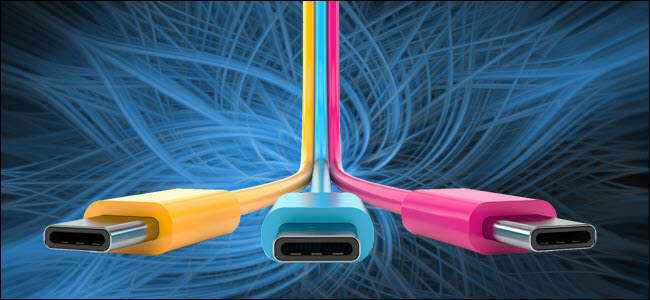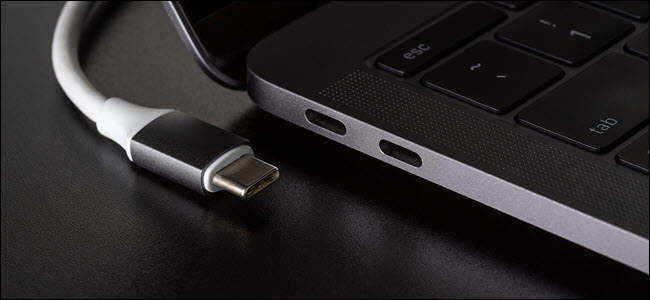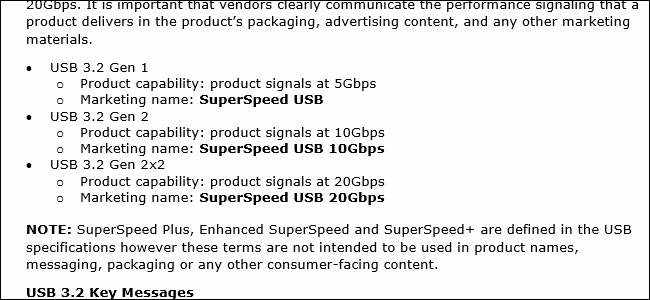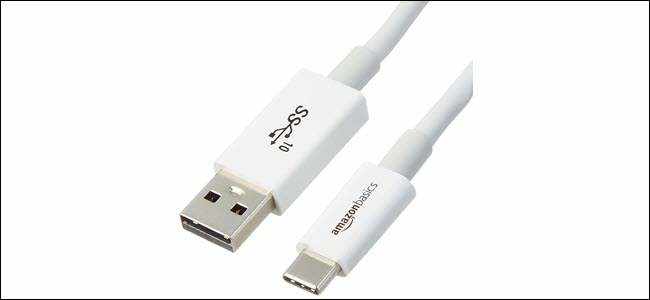
usb gen1 gen2

Finding the fastest USB connection used to be easy: choose USB 3.0 instead of 2.0. But now, you’ll need to know the difference between USB 3.2 Gen 1, Gen 2, and Gen 2×2—and what various types of “SuperSpeed” mean, too.
查找以前最快的USB连接很容易:选择USB 3.0而不是2.0。 但是现在,您需要了解USB 3.2 Gen 1,Gen 2和Gen 2×2之间的区别,以及各种类型的“ SuperSpeed”也意味着什么。

Once upon a time, USB came in two main flavors, 2.0 and 3.0. All you needed to know about them was 3.0 was faster than 2.0. You could buy a USB 2.0 flash drive and plug it into a computer that had USB 3.0 slots, and it would still work—just at the slower USB 2.0 speeds. Buying a USB 3.0 drive and plugging it into a USB 2.0 port would give you USB 2.0 speeds, too.
曾几何时,USB有两种主要版本,即2.0和3.0。 您需要了解的所有信息都是3.0快于2.0。 您可以购买USB 2.0闪存驱动器,然后将其插入具有USB 3.0插槽的计算机,它仍然可以工作-只是在USB 2.0速度较慢时。 购买USB 3.0驱动器并将其插入USB 2.0端口也将为您提供USB 2.0速度。
If you wanted the fastest speed possible, you’d get a USB 3.0 drive and plug it into a USB 3.0 USB port. It was simple and straightforward. But everything changed with USB 3.1.
如果您想要最快的速度,则可以使用USB 3.0驱动器并将其插入USB 3.0 USB端口。 这很简单明了。 但是,USB 3.1改变了一切。

The USB Implementors Forums (USB-IF) maintains USB specifications and compliance, and it’s behind the naming schemes found on USB cables and devices. When it introduced USB 3.1, rather than keep things simple and let that name differentiate from USB 3.0, it called the new standard “USB 3.1 Gen 2.” USB 3.0 was retroactively renamed “USB 3.1 Gen 1.”
USB实施者论坛 (USB-IF)保持USB规范和合规性,并且落后于USB电缆和设备上的命名方案。 当推出USB 3.1时,它并没有使事情变得简单,并且使名称不同于USB 3.0,而是将其称为新标准“ USB 3.1 Gen 2”。 USB 3.0被追溯更名为“ USB 3.1 Gen 1”。
To further complicate things, the transfer speeds themselves received names. USB 3.1 Gen 1, originally known as USB 3.0, is capable of 5 Gbps transfer speeds—that’s called SuperSpeed.
更复杂的是,传输本身会加快接收名称的速度。 USB 3.1 Gen 1(最初称为USB 3.0)具有5 Gbps的传输速度,即SuperSpeed。
USB 3.1 Gen 2 is capable of 10 Gbps transfer speeds—that’s called SuperSpeed+. Technically, it accomplishes this by using 128b/132b encoding in a full-duplex communications mode. Full-duplex communication is exciting because that means information can be transferred and received at the same time. That’s why it’s faster.
USB 3.1 Gen 2能够达到10 Gbps的传输速度,即SuperSpeed +。 从技术上讲,它是通过在全双工通信模式下使用128b / 132b编码来实现的。 全双工通信令人兴奋,因为这意味着可以同时传输和接收信息。 这就是为什么它更快。
The difference between the two was slightly confusing. But, as long as you remembered Gen 2 was better than Gen 1, you were good to go. To help differentiate the speeds, USB-IF also implemented logos, which manufacturer can only use by passing a certification to prove a cable matches the promised specs.
两者之间的区别有点令人困惑。 但是,只要您记得第二代比第一代更好,那您就很乐意。 为了帮助区分速度,USB-IF还实施了徽标,制造商只能通过通过认证以证明电缆符合承诺规格的徽标。

Last September, the USB-IF detailed out new possible speeds for USB-C, and the beginnings of the USB 3.2 specification. USB 3.2 will be capable of 20 Gbps speeds. That’s double the transfer speeds of USB 3.1 Gen 2. If you’re wondering how the cables are doubling their speed so quickly without changing size or connectors, it’s straight forward. USB products capable of 20 Gbps have two 10 Gbps channels. Think of it as more wiring jammed into the same cable.
去年9月,USB-IF详细介绍了USB-C可能的新速度以及USB 3.2规范的开始。 USB 3.2将具有20 Gbps的速度。 这是USB 3.1 Gen 2的传输速度的两倍。如果您想知道电缆如何在不改变尺寸或连接器的情况下如此快速地将其速度提高一倍,那是很简单的。 能够达到20 Gbps的USB产品具有两个10 Gbps通道。 可以将它想象为更多的电线卡在同一根电缆中。
Just like in previous iterations, this new standard is backward compatible for basic usage—but you won’t get the faster speed without all new hardware. If you buy a hard drive that promises a 20 Gbps transfer rate and plug it into your current computer, the hard drive will work, but at slower speeds that the USB ports on your machine can provide. You’ll have to update both ends of the connection to enjoy all the new benefits.
就像在先前的迭代中一样,此新标准对基本用法向后兼容-但是如果没有所有新硬件,您将无法获得更快的速度。 如果您购买的硬盘驱动器可以保证20 Gbps的传输速率,并将其插入当前计算机,则该硬盘驱动器可以工作,但计算机上USB端口可以提供的速度较慢。 您必须更新连接的两端才能享受所有新的好处。
At Mobile World Congress 2019, the USB-IF announced the branding and naming schemes for the new standard. And once again, the previous naming will be discarded and changed retroactively.
在2019年世界移动通信大会上,USB-IF宣布了新标准的品牌和命名方案。 再一次,先前的命名将被丢弃并追溯更改。
Going forward, what used to be USB 3.0, with 5 Gbps transfer speeds, will be USB 3.2 Gen 1. USB 3.1 Gen 2, with its 10 Gbps speeds, will be renamed to USB 3.2 Gen 2.
展望未来,传输速度为5 Gbps的USB 3.0将被称为USB 3.2 Gen1。其速度为10 Gbps的USB 3.1 Gen 2将被重命名为USB 3.2 Gen 2。
The new 20 Gbps standard will be named USB 3.2 Gen 2×2, breaking the predictable pattern. Physically, this has two 10 Gbps channel, so it literally is 2×2. There’s a logic to the name, but it’s confusing, and you have to understand the hardware to realize it makes any sense.
新的20 Gbps标准将命名为USB 3.2 Gen 2×2,打破了可预测的模式。 从物理上讲,它具有两个10 Gbps通道,因此从字面上看是2×2。 名称有其逻辑,但令人困惑,您必须了解硬件才能意识到它的意义。

USB-IF doesn’t want consumers to see these terms. Instead, it wants Gen 1 products marketed as SuperSpeed USB. It suggests manufacturers market Gen 2 products as SuperSpeed USB 10 Gbps and Gen 2×2 as SuperSpeed USB 20 Gbps. But that doesn’t mean manufacturers have to use these names. Manufacturers can use the Gen 2.2 nomenclature—or if they don’t bother to submit to testing and compliance, they can forgo the logos and use any name they feel like.
USB-IF不希望消费者看到这些术语。 相反,它希望将第一代产品销售为SuperSpeed USB。 它建议制造商将Gen 2产品作为SuperSpeed USB 10 Gbps进行销售,将Gen 2×2作为SuperSpeed USB 20 Gbps进行销售。 但这并不意味着制造商必须使用这些名称。 制造商可以使用Gen 2.2命名法,或者,如果他们不愿意接受测试和合规性,则可以放弃徽标并使用他们喜欢的任何名称。
If manufacturers do comply, the naming issue is pretty straight forward. Look for “SuperSpeed” in the name and check if there’s a number. If you don’t see one, it’s the slowest USB 3.2 type. If you see a 10 or a 20, that’s the promise of 10 Gbps or 20 Gbps transfers. It might have been better if USB-IF had gone with SuperSpeed USB 5 Gbps for the slowest type. But at least it’s fairly straight forward.
如果制造商确实遵守,则命名问题将非常简单。 在名称中查找“ SuperSpeed”,然后检查是否有数字。 如果看不到,那是最慢的USB 3.2类型。 如果看到10或20,则表示10 Gbps或20 Gbps传输的承诺。 如果将USB-IF与最慢的类型的SuperSpeed USB 5 Gbps一起使用,可能会更好。 但这至少是相当简单的。
In theory, USB logos should help. As seen in the image above, the SS and 10 denote that USB cable as a SuperSpeed cable capable of 10 Gbps transfers. Unfortunately, the USB-IF has not shown the official certification mark for SuperSpeed USB 20 yet. Presumably, it should be the same logo as above, just with a 20 in its place. But we don’t know that for certain yet.
从理论上讲,USB徽标应该有所帮助。 如上图所示,SS和10表示USB电缆是能够进行10 Gbps传输的SuperSpeed电缆。 不幸的是,USB-IF尚未显示SuperSpeed USB 20的官方认证标志。 大概应该是与上面相同的徽标,只不过是20的位置。 但是我们还不确定。
If you remember USB-C’s early issues, this will probably seem very familiar. Read carefully before buying cables, and buy them from reputable, trusted sources. In the past, we’ve recommended Amazon Basics cables—but even with those you still need to look carefully. For instance, this Amazon Basics cable is USB-C but only offers 2.0 speeds. This Amazon Basics cable, which looks practically the same, offers 10 Gbps transfers and is marked as USB 3.1 Gen 2. And, of course, this doesn’t just apply to USB cables. It applies to any piece of hardware that uses USB-C.
如果您还记得USB-C的早期问题 ,这可能看起来非常熟悉。 在购买电缆之前,请仔细阅读并从信誉良好的可信赖来源购买电缆。 过去,我们推荐使用Amazon Basics电缆,但是即使是那些电缆,您仍然需要仔细观察。 例如,此Amazon Basics电缆为USB-C,但仅提供2.0速度。 该Amazon Basics电缆外观几乎相同,可提供10 Gbps传输,并标记为USB 3.1 Gen2。当然,这不仅适用于USB电缆。 它适用于使用USB-C的任何硬件。
Unfortunately, this is still a mess of confusing terms. You’ll need to do your due diligence when buying USB hardware to know exactly what you’re getting.
不幸的是,这仍然是混乱的术语。 购买USB硬件时,您需要进行尽职调查以确切了解所获得的内容。
翻译自: https://www.howtogeek.com/406199/what-are-usb-gen-1-gen-2-and-gen-2x2/
usb gen1 gen2

 京公网安备 11010802041100号 | 京ICP备19059560号-4 | PHP1.CN 第一PHP社区 版权所有
京公网安备 11010802041100号 | 京ICP备19059560号-4 | PHP1.CN 第一PHP社区 版权所有